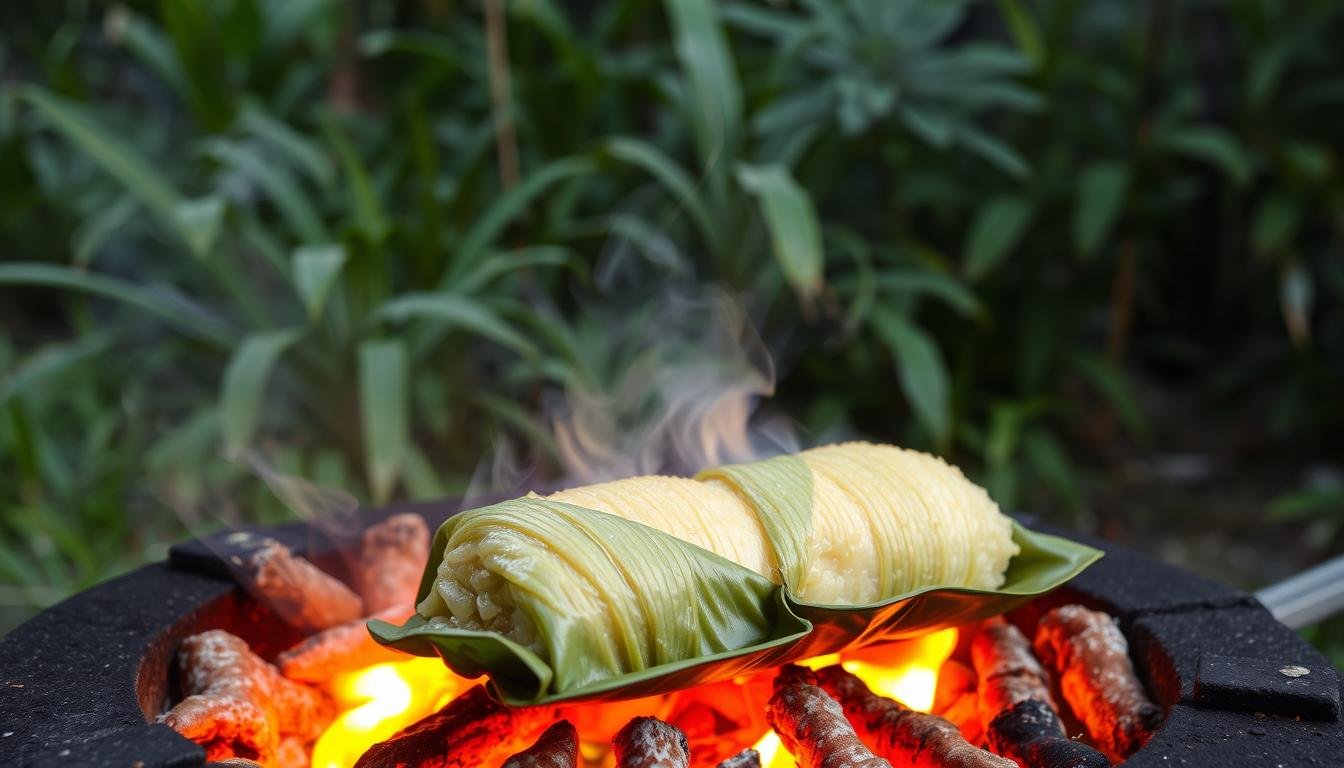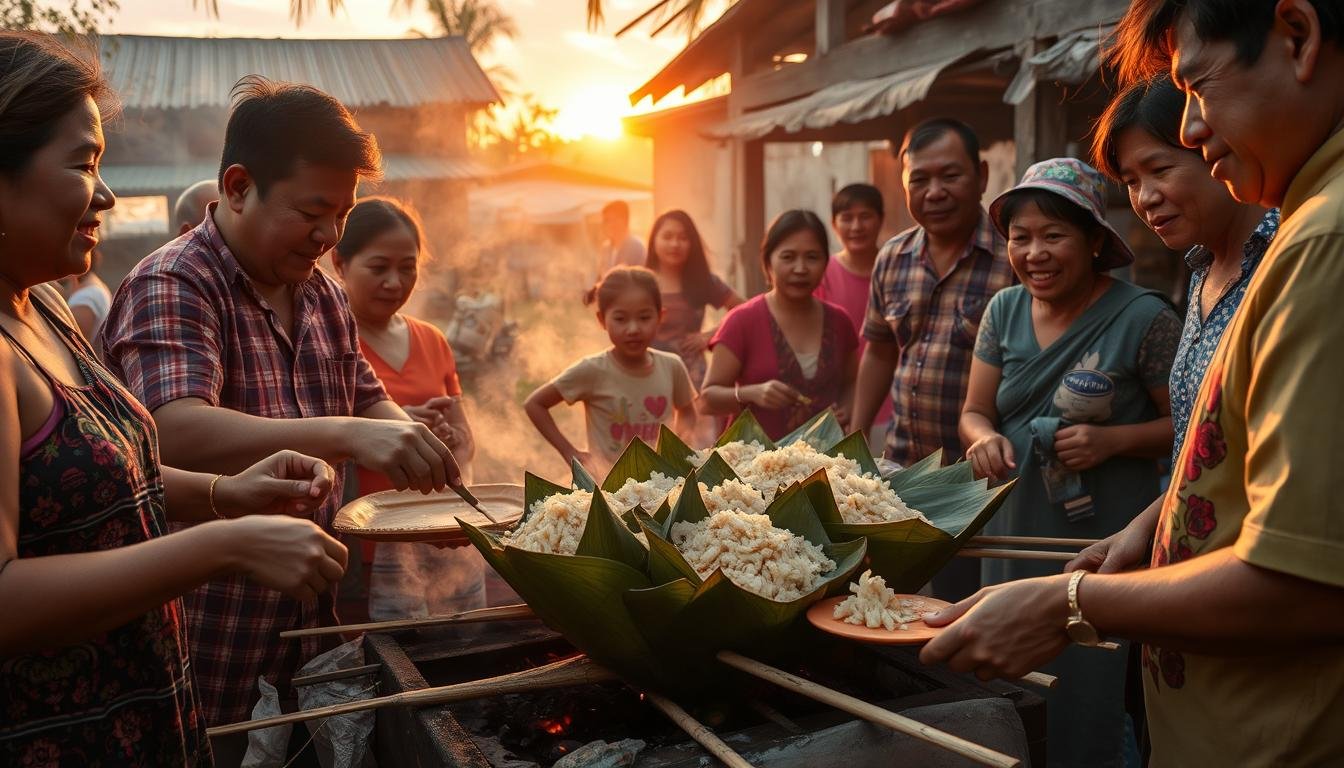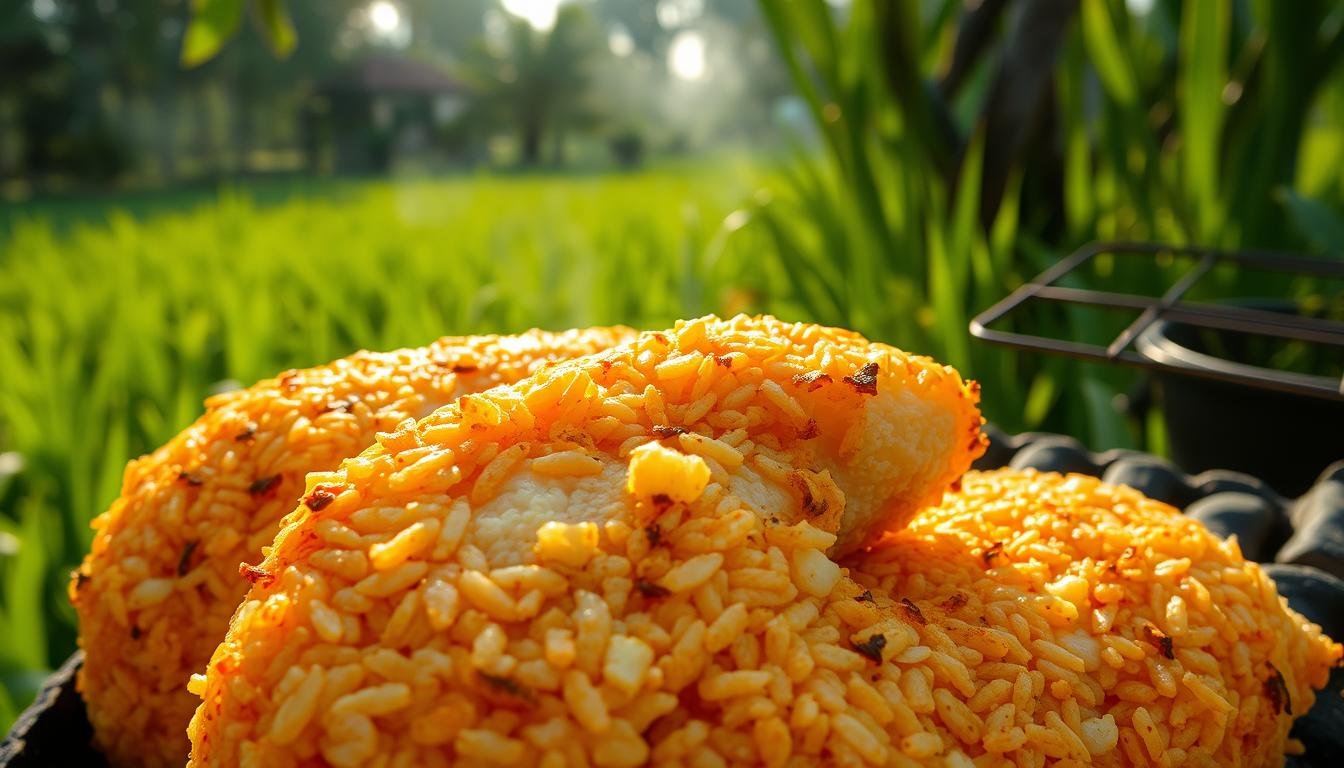Have you ever tried a Filipino dish that mixes coconut sweetness, chewy rice, and grilled banana leaves? Welcome to Tupig, a favorite from Pangasinan, Philippines.
Tupig, also known as “kangkanen” or “intemtem,” is a special rice cake. It’s a key part of northwestern Luzon’s food traditions. Made with glutinous rice flour, brown sugar, and young coconut, it’s wrapped in banana leaves and grilled. This makes it a delicious treat.
Key Takeaways
- Tupig is a unique Filipino rice cake originating from the Pangasinan region, known for its sweet and smoky flavor profile.
- The dish is made with a mixture of glutinous rice flour, brown sugar or muscovado, and young coconut meat, wrapped in banana leaves and grilled.
- Tupig can be cooked using traditional methods like charcoal grilling or modern techniques like pan-frying.
- Variations of Tupig include ingredients like ube (purple yam), peanuts, and even salted egg.
- Tupig holds significant cultural and culinary importance in the Pangasinan region, offering a delightful taste of Filipino heritage.
Ingredients and Preparation
Making tupig, a favorite grilled rice dish from Pangasinan, Philippines, begins with the right ingredients. You’ll need glutinous rice flour, coconut milk, and a bit of sweetness from brown sugar or muscovado sugar. These ingredients mix to give tupig its chewy texture and rich coconut taste.
Glutinous rice flour is key for its chewy texture. Coconut milk adds creaminess and a fragrant flavor. Sweeteners like brown sugar or muscovado sugar balance the taste and add a caramel color.
Young coconut meat, or macapuno, adds extra texture and tropical taste. These soft coconut strips enhance the coconut flavor and add chewiness.
The last step is wrapping the mixture in banana leaves. These leaves cook the tupig and add a unique aroma and flavor. If banana leaves are hard to find, corn husks work well too.
With these ingredients and the traditional wrapping method, the grilling of tupig begins. This process promises a flavorful and textured experience.
Key Ingredients for Tupig
- Glutinous rice flour
- Coconut milk
- Brown sugar or muscovado sugar
- Macapuno (young coconut strips)
- Banana leaves (or corn husks as an alternative)
- Salt (to balance the sweetness)
The right mix of these ingredients, wrapped and grilled, creates tupig. It’s a true taste of Pangasinan’s culinary heritage.
Grilling Process
The traditional way to grill Tupig is over hot charcoal. This gives the dish a unique smoky flavor. The charcoal grill’s heat makes the Tupig’s outside dark and charred, which matches its sweet inside perfectly.
If you don’t have an outdoor grill, you can use a grill pan on the stovetop. This method is easier and still gives a grilled texture and smoky essence. You can also bake Tupig in the oven, but it won’t have the same traditional grilling taste.
The secret to great Tupig is a charred outside that contrasts with its sweet inside. This mix of textures and tastes makes Tupig a favorite in the Philippines.
Traditional Grilling Methods (Over Charcoal)
- Prepare a hot charcoal grill with an even layer of glowing embers.
- Place the Tupig, wrapped in banana leaves, directly on the grill grates.
- Cook for approximately 30 minutes, turning the Tupig halfway through to ensure even charring.
- The Tupig is ready when the exterior is dark and crispy, and the interior is soft and sweet.
Modern Grilling Techniques (Using a Grill Pan)
- Heat a grill pan over medium-high heat until it’s hot and ready for grilling.
- Place the unwrapped Tupig directly on the preheated grill pan.
- Cook for about 15 minutes on each side, or until the Tupig develops a charred and crispy exterior.
- This method allows for greater control and convenience, while still imparting a smoky flavor to the Tupig.

The importance of grilling Tupig can’t be overstated. Whether using traditional charcoal grilling or modern grill pan technique, both are key to its signature smoky flavor and charred texture. These elements make Tupig a beloved and iconic Filipino dish.
Flavor Variations
The classic tupig is a mix of sweetness and smokiness. But, there are also tasty variations with ube (purple yam), pandan, and salted egg. These new flavors make tupig exciting for more people.
Classic Tupig
The tupig is a favorite in the Philippines. It’s a mix of sweet and smoky tastes. It’s soft, chewy, and has a caramelized outside.
Popular Flavor Variations
- Ube Tupig: This version has the creamy taste of purple yam. It’s a fun twist to the classic tupig.
- Pandan Tupig: This one has a fragrant and sweet aroma from pandan. It’s a unique flavor.
- Salted Egg Tupig: This version is savory. It has the bold taste of salted egg mixed with sweetness.
Creative Flavor Combinations
Cooks have also tried new flavor variations like jackfruit, guava, and strawberry. These new flavors show how versatile tupig can be.
Tupig is loved for its rich history and many flavors. It’s a favorite in the Philippines. Whether you like the classic taste or the new ones, tupig is a must-try.
Cultural Significance and Traditions
Tupig, a sweet and smoky grilled rice dish from Pangasinan, is very important in the region. It’s a key part of local celebrations and festivals. It’s also tied to the area’s culinary heritage and is featured in many legends from the province.
The way tupig is made and eaten is a big part of Pangasinan’s traditions. During Christmas, the smell of grilled tupig is everywhere. It’s a favorite at Misa de Gallo. Kids who sing Christmas carols are often given tupig instead of money, keeping the tradition alive.
The provincial government of Pangasinan hosts a big Christmas festival called “Paskua Mi Ditoy.” It’s a month-long event that celebrates tupig-making. The best tupig makers from places like Ilocos Sur and Tarlac come to show off their skills.

Making tupig is a tradition passed down in the Ilocos region. It keeps the local culinary heritage alive. Tupig is a big cultural symbol during Christmas, showing the rich traditions and celebrations of the Pangasinan people.
Enjoying Tupig
Tupig, a grilled rice treat from Pangasinan, is loved in many ways. It’s great as a snack or with coffee for a tasty mix. It also adds sweetness to Filipino meals, making them even better.
Traditional Serving and Pairing
Let tupig cool a bit before you unwrap it. This makes it perfect, with a crispy outside and soft inside. It’s amazing with coffee, lemonade, or iced tea.
Pairing with Filipino Dishes
Tupig is more than just a snack. It’s great with Filipino dishes like ginataang kalabasa, tofu sisig, or ensaladang talong. It adds a sweet touch to savory meals.
Serving Tips
- Let tupig cool slightly before unwrapping for the best texture.
- Enjoy tupig with Filipino drinks like coffee, lemonade, or iced tea.
- Try tupig with savory dishes like ginataang kalabasa, tofu sisig, or ensaladang talong for a unique taste.
Learning how to serve and pair tupig brings out its rich flavors. It’s a true taste of Pangasinan’s culinary tradition. Enjoy it as a snack or with meals for a special treat.
Conclusion
Tupig is a beloved dish from Pangasinan, known for its sweet and smoky taste. It’s a must-try for those exploring Filipino cuisine. Readers are encouraged to try making tupig at home to experience its authentic flavor.
The project spent PHP 579,320.40 to improve rice-based products like tupig. Researchers found ways to keep tupig fresh for longer. They discovered how to keep it fresh for 14 days at room temperature, 60 days in the fridge, and 180 days in the freezer.
Tupig holds a special place in Dagupan’s culture, along with bibingka. These dishes show the city’s rich traditions and flavors. Enjoying tupig as a snack or with local dishes helps appreciate Pangasinan’s culinary heritage.
FAQ
What is tupig?
What are the essential ingredients for making tupig?
How is tupig traditionally cooked?
What are the different flavor variations of tupig?
What is the cultural significance of tupig?
How is tupig typically enjoyed?
Source Links
- Tupig in Frying Pan – Yummy Kitchen
- Tupig | Amiable Foods
- Ultimate Homemade Tupig Recipe
- Oven-Baked Tupig (Tinupig) – PinoyBites
- Tupig
- The Philippines’s alternative weekly magazine
- Tupig
- TUPIG, TINUBONG AND SINABALU
- Tupig From Tarlac — Positively Filipino | Online Magazine for Filipinos in the Diaspora
- ‘Tupig’ is Ilocanos’ reminder of Christmas
- tupig – ofRainbowsandButterflies
- Tupig na Saba Recipe
- 🇵🇭 DAGUPAN • Tupig and Bibingka: Local Tastes Near the City Plaza
- Improving the Quality and Shelf Life of Tupig and Other Rice-based Products / Rachel F. Rocafort
